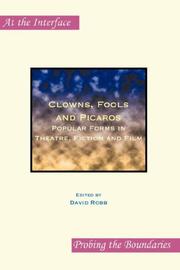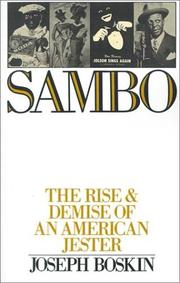| Listing 1 - 10 of 14 | << page >> |
Sort by
|
Book
ISBN: 144389429X 9781443894296 9781443890502 Year: 2016 Publisher: Newcastle upon Tyne, England : Cambridge Scholars Publishing,
Abstract | Keywords | Export | Availability | Bookmark
 Loading...
Loading...Choose an application
- Reference Manager
- EndNote
- RefWorks (Direct export to RefWorks)
To prepare for the role of the Joker, Heath Ledger locked himself in a London hotel room, trying to understand and become a character he saw as "an absolute sociopath, a cold-blooded, mass-murdering clown" who was not intimidated by anything and found all of life "a big joke." In the end, Ledger's obsession with his role contributed to his own death from drugs before The Dark Knight was released. The connections and irony are too close to ignore. The movie gives the world a curious twist on the roles of Batman and the Joker. It's politically incorrect, and yet emotionally the Joker's insanity
Book
ISBN: 0826356672 9780826356673 9780826356666 0826356664 Year: 2016 Publisher: Albuquerque
Abstract | Keywords | Export | Availability | Bookmark
 Loading...
Loading...Choose an application
- Reference Manager
- EndNote
- RefWorks (Direct export to RefWorks)
Bad clowns--those malicious misfits of the midway who terrorize, haunt, and threaten us--have long been a cultural icon. This book describes the history of bad clowns, why clowns go bad, and why many people fear them. Going beyond familiar clowns such as the Joker, Krusty, John Wayne Gacy, and Stephen King's Pennywise, it also features bizarre, lesser-known stories of weird clown antics including Bozo obscenity, Ronald McDonald haters, killer clowns, phantom-clown abductors, evil-clown panics, sex clowns, carnival clowns, troll clowns, and much more. Bad Clowns blends humor, investigation, and scholarship to reveal what is behind the clown's dark smile. This book describes the history of bad clowns, why clowns go bad, and why many people fear them.
Clowns --- Circus performers --- Entertainers --- Fools and jesters --- Comedians --- History. --- Clowns.
Book
ISBN: 1501727117 1501727125 9781501727122 9781501727139 1501727133 9781501727108 1501727109 9781501727108 9781501727115 Year: 2018 Publisher: Ithaca, NY : Cornell University Press,
Abstract | Keywords | Export | Availability | Bookmark
 Loading...
Loading...Choose an application
- Reference Manager
- EndNote
- RefWorks (Direct export to RefWorks)
Joel B. Lande's Persistence of Folly challenges the accepted account of the origins of German theater by focusing on the misunderstood figure of the fool, whose spontaneous and impish jest captivated audiences, critics, and playwrights from the late sixteenth through the early nineteenth century. Lande radically expands the scope of literary historical inquiry, showing that the fool was not a distraction from attempts to establish a serious dramatic tradition in the German language. Instead, the fool was both a fixture on the stage and a nearly ubiquitous theme in an array of literary critical, governmental, moral-philosophical, and medical discourses, figuring centrally in broad-based efforts to assign laughter a proper time, place, and proportion in society.Persistence of Folly reveals the fool as a cornerstone of the dynamic process that culminated in the works of Lessing, Goethe, and Kleist. By reorienting the history of German theater, Lande's work conclusively shows that the highpoint of German literature around 1800 did not eliminate irreverent jest in the name of serious drama, but instead developed highly refined techniques for integrating the comic tradition of the stage fool.
German drama (Comedy) --- Fools and jesters in literature. --- German drama --- History and criticism.

ISBN: 9401205396 1435613384 9781435613386 9042023406 9789042023406 9789042023406 9042023406 9789401205399 Year: 2007 Publisher: Amsterdam New York, NY Rodopi
Abstract | Keywords | Export | Availability | Bookmark
 Loading...
Loading...Choose an application
- Reference Manager
- EndNote
- RefWorks (Direct export to RefWorks)
By its very nature the clown, as represented in art, is an interdisciplinary phenomenon. In whichever artform it appears – fiction, drama, film, photography or fine art – it carries the symbolic association of its usage in popular culture, be it ritual festivities, street theatre or circus. The clown, like its extended family of fools, jesters, picaros and tricksters, has a variety of functions all focussed around its status and image of being “other.” Frequently a marginalized figure, it provides the foil for the shortcomings of dominant discourse or the absurdities of human behaviour. Clowns, Fools and Picaros represents the latest research on the clown, bringing together for the first time studies from four continents: Europe, America, Africa and Asia. It attempts to ascertain commonalities, overlaps and differences between artistic expressions of the “clownesque” from these various continents and genres, and above all, to examine the role of the clown in our cultures today. This volume is of interest for scholars of political and comic drama, film and visual art as well as scholars of comparative literature and anthropology.
Clowns in literature --- Fools and jesters in literature --- Tricksters in literature --- Clowns --- Theater --- Postmodernism (Literature) --- Clowns. --- Clowns in literature. --- Fools and jesters in literature. --- Theater. --- Tricksters in literature. --- Trickster in literature --- Tricksters as literary characters --- Dramatics --- Histrionics --- Professional theater --- Stage --- Theatre --- Performing arts --- Acting --- Actors --- Literary movements --- Literature, Modern --- Modernism (Literature) --- Post-postmodernism (Literature) --- Clowns as literary characters --- Circus performers --- Entertainers --- Fools and jesters --- Comedians --- History --- Fools and jesters. --- Court fools --- Jesters --- Courts and courtiers --- Favorites, Royal --- Joking
Multi
ISBN: 9781107036574 1107036577 9781139567794 1108438776 1107779588 1107777089 1107780055 1139567799 1107778786 1107781299 1107784492 1107784956 Year: 2014 Publisher: Cambridge Cambridge University Press
Abstract | Keywords | Export | Availability | Bookmark
 Loading...
Loading...Choose an application
- Reference Manager
- EndNote
- RefWorks (Direct export to RefWorks)
To early modern audiences, the 'clown' was much more than a minor play character. A celebrity performer, he was a one-man sideshow whose interactive entertainments - face-pulling, farce interludes, jigs, rhyming contests with the crowd - were the main event. Clowning epitomized a theatre that was heterogeneous, improvised, participatory, and irreducible to dramatic texts. How, then, did those texts emerge? Why did playgoers buy books that deleted not only the clown, but them as well? Challenging the narrative that clowns were 'banished' by playwrights like Shakespeare and Jonson, Richard Preiss argues that clowns such as Richard Tarlton, Will Kemp, and Robert Armin actually made playwrights possible - bridging, through the publication of their routines, the experience of 'live' and scripted performance. Clowning and Authorship tells the story of how, as the clown's presence decayed into print, he bequeathed the new categories around which theatre would organize: the author, and the actor.
English literature --- Thematology --- Drama --- anno 1500-1599 --- English drama --- Fools and jesters in literature. --- Clowns in literature. --- History and criticism.
Book
ISBN: 9062623816 Year: 1983 Publisher: Weesp Heureka
Abstract | Keywords | Export | Availability | Bookmark
 Loading...
Loading...Choose an application
- Reference Manager
- EndNote
- RefWorks (Direct export to RefWorks)
jesters --- dwarfs --- Iconography --- History of civilization --- Theatrical science --- anno 1500-1799 --- circus --- Fools and jesters --- -#gsdb8 --- 82-2 --- Court fools --- Jesters --- Courts and courtiers --- Favorites, Royal --- Joking --- History KUL --- Toneel. Drama --- History. --- 82-2 Toneel. Drama --- History --- #gsdb8 --- hofnar. --- zotheid. --- geschiedenis. --- middeleeuwen, middeleeuwse geschiedenis (historisch tijdvak). --- Shakespeare, William. --- circus.
Book
ISBN: 1282372556 9786612372551 3484971193 9783484971196 9781282372559 9783484366336 Year: 2009 Publisher: Tübingen M. Niemeyer
Abstract | Keywords | Export | Availability | Bookmark
 Loading...
Loading...Choose an application
- Reference Manager
- EndNote
- RefWorks (Direct export to RefWorks)
Anhand des 1572 erstmalig gedruckten und bis ins 18. Jahrhundert weit verbreiteten Schwankromans Historien von Claus Narren erläutert die Studie den Begriff der natürlichen Narrheit und dessen didaktische Funktionalisierung durch den protestantischen Verfasser Wolfgang Büttner. Mit Hilfe von diskursanalytischen und ritualtheoretischen Ansätzen wird herausgearbeitet, welche Funktionen den als mental different begriffenen natürlichen Narren in Mittelalter und Früher Neuzeit zukamen. Natürliche Narren repräsentieren eine institutionalisierte Form der Liminalität. Zwar wurden sie zusammen mit den Schalks- bzw. künstlichen Narren an Höfen gehalten, galten aber nicht nur als zu verlachende Objekte, sondern gleichzeitig auch als Wunder, Wunderzeichen und Exempel. Büttners Werk baut auf dieser Narrenkonfiguration auf und integriert sie in sein Werk, das 626 Historien mit jeweils angehängten Lehren umfasst. Im Mittelpunkt steht der ebenfalls historisch nachweisbare ernestinische Hofnarr Claus Narr. Die Narrenfigur dient in den Historien von Claus Narren dazu, Normen und Normenübertretung zu problematisieren, um daraus religiöse und moralische Verhaltensvorschriften zu gewinnen.
German wit and humor --- Fools and jesters in literature. --- History and criticism. --- Büttner, Wolfgang, --- 16th Century Literature. --- Claus Narr. --- Fools in Literature. --- Wolfgang Büttner. --- Buttner, Wolfgang,

ISBN: 1280523603 9786610523603 0195363531 9780195363531 9781280523601 9780195056587 0195056582 6610523606 Year: 1988 Publisher: New York Oxford University Press
Abstract | Keywords | Export | Availability | Bookmark
 Loading...
Loading...Choose an application
- Reference Manager
- EndNote
- RefWorks (Direct export to RefWorks)
Traces the history of comic stereotype of the Black performer and explains how it was finally eradicated.
Book
ISBN: 0720484529 9780720484526 Year: 1979 Volume: 100 Publisher: Amsterdam North-Holland
Abstract | Keywords | Export | Availability | Bookmark
 Loading...
Loading...Choose an application
- Reference Manager
- EndNote
- RefWorks (Direct export to RefWorks)
Sanskrit drama --- -Vidusaka --- Varuna (Hindu deity) --- History and criticism --- -Varuṇa (Hindu deity) --- Vidusaka --- Hindu gods --- Sanskrit literature --- Fools and jesters in literature. --- Varuṇa (Hindu deity) --- Varuṇa (Hindu deity) --- History and criticism. --- Varuṇa (Hindu deity). --- Varuṇa (Hindu deity). --- Fools and jesters in literature --- Sanskrit drama - - History and criticism
Book
ISBN: 0521225132 Year: 1980 Publisher: Cambridge Cambridge university press
Abstract | Keywords | Export | Availability | Bookmark
 Loading...
Loading...Choose an application
- Reference Manager
- EndNote
- RefWorks (Direct export to RefWorks)
French literature --- Drama --- anno 1400-1499 --- anno 1500-1599 --- Civilization, Medieval, in literature. --- Fools and jesters in literature. --- French drama --- Satire, French --- Soties --- History and criticism. --- History and criticism
| Listing 1 - 10 of 14 | << page >> |
Sort by
|

 Search
Search Feedback
Feedback About UniCat
About UniCat  Help
Help News
News